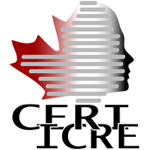Dr. Mircea Steriade died on
April 14, 2006 after a long fight with cancer.
Born in Romania in 1924, Dr.
Steriade completed medical studies in 1952 and a doctorate of sciences in
1995. He was a practicing neurologist
until 1957 and then undertook post-doctoral studies at Université de
Bruxelles. In 1958, he returned to the Academy of Sciences
of Bucharest
where he headed the Laboratory of Neurophysiology until 1968. Criticized by the communist party for
publishing his work in American scientific journals, Dr. Steriade took
advantage of a scientific meeting in France to defect. Symbolically, he left Romania for Paris in
May 1968, at the peak of the student uprisings.
During his stay in France, he met a fellow scientist from Montreal that
offered him a visiting professor position at Université de Montréal. A few months later, he accepted a professor
position a Université Laval, where he continued to work until his death. Since June 2004, he was also a visiting
professor in the Department of Physiology at Université de Montréal.
Mircea Steriade, at the 2nd Meeting of the Canadian Epilepsy Research Initiative, Montreal, 30 September 2001
It is difficult to convey, in
a few lines, the full impact of such a productive and distinguished career as
that of Dr. Steriade. He published over
400 scientific papers in prestigious scientific journals, 8 books and 42
chapters/review papers. In the first
part of his career, Dr. Steriade studied how the activity of neurons in the
thalamus and cerebral cortex fluctuates during the sleep-wake cycle. More than anyone, he demonstrated that sleep
is not a state in which the brain "rests”. To the contrary, he found that sleep
is a dynamic state during which the activity of thalamic and cortical neurons
is reorganized in oscillatory phenomena that are generated at diverse
frequencies. At the time, he also noted
the similarities between these sleep rhythms and the hypersynchronous neural
activity observed during certain forms of epilepsy.
Next, he probed the mechanisms
underlying the fluctuations in neural activity that are produced at the level
of the thalamus and cerebral cortex during sleep-wake cycles. He demonstrated that a group of cholinergic
neurons, located at the junction of the pons and mesencephalon, control the
state of the thalamocortical network.
During the 80's, taking
advantage of novel experimental methods, he revealed the cellular mechanisms
responsible for the diverse thalamocortical rhythms he had described earlier in
his career. Even though he already had a
major international scientific reputation, it is during this period that his
work began having a major impact in the scientific community in part because it
constituted the first detailed analysis of intrinsic and synaptic mechanisms
governing interactions between cortical and thalamic neurons. Moreover, these studies revealed the intimate
meaning of phenomena observed with electroencephalography, one of the most
commonly used techniques in clinical neurology.
In the early 90"s, Steriade
discovered a new sleep oscillation (termed the slow oscillation because its
frequency was < 1Hz). This previously
unknown activity pattern (now referred as to up and down states) attracted a
lot of attention because it is ubiquitous and it paces the faster sleep
oscillations (spindles, delta) that had been described earlier. Steriade soon recognized that this slow
oscillation could become hypersynchronized and lead to the genesis of epileptic
discharges, an important line of inquiry during the last decade of his
life.
The impact of Steriade's
contributions in Systems Neuroscience cannot be overemphasized. He will be sadly
missed by his many friends, former students, and colleagues. Our deepest sympathies go to his family.
Denis Paré, Ph.D.
Rutgers University
Jean-Claude Lacaille, Ph.D.
Université de Montréal |
